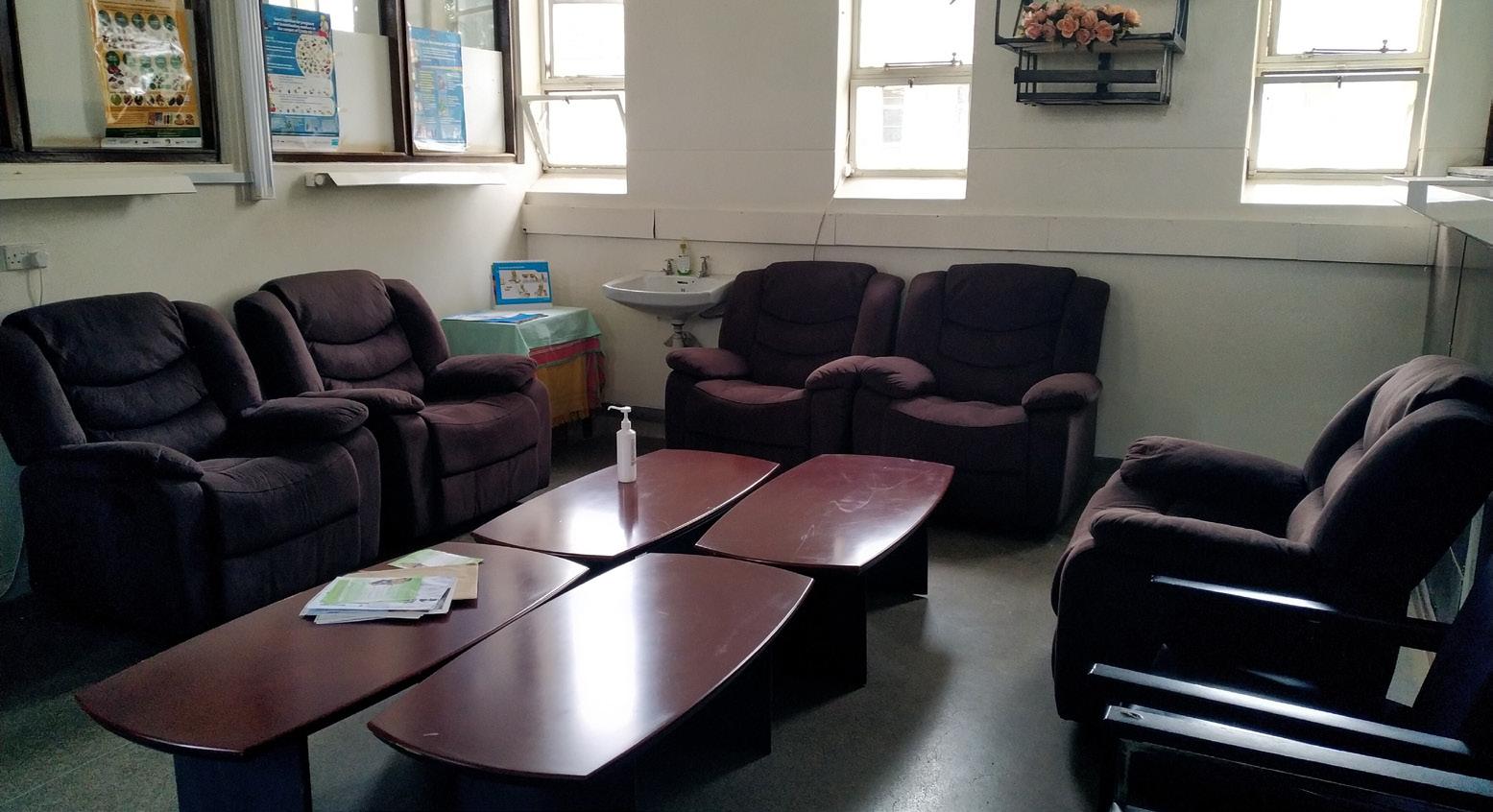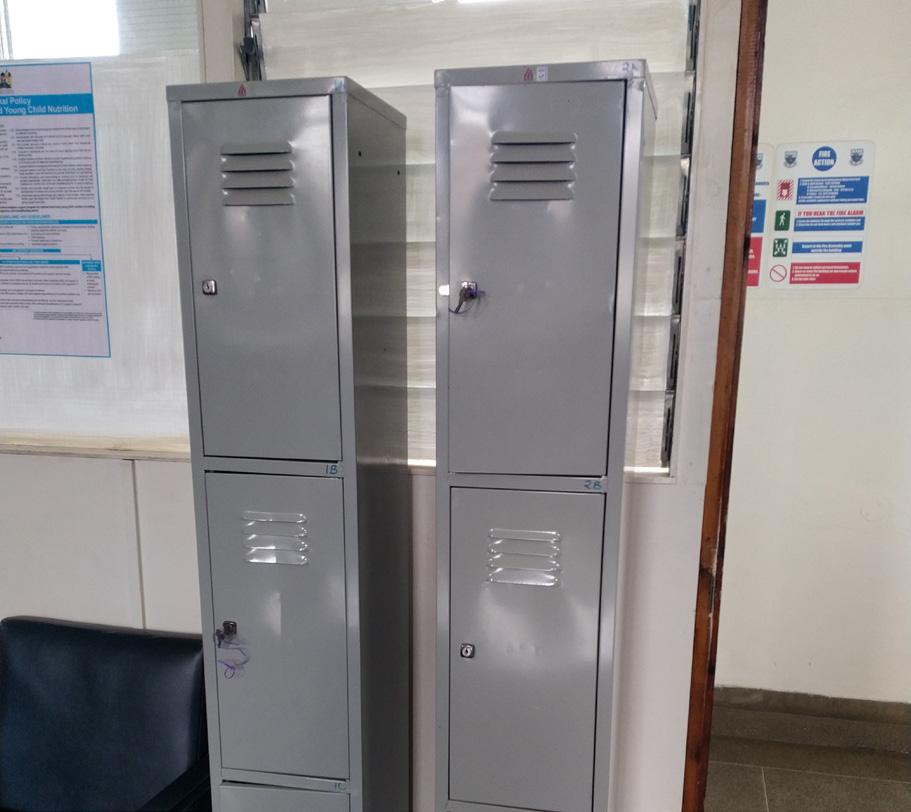
8 minute read
Staff lactation room available for working mothers at KNH
Staff lactation room available for working mothers at KNH
By Sheila Murithi
Advertisement
Breastfeeding is the best source for an infant’s nutrition and contributes to maternal health. The World Health Organization (WHO) and the United Nations International
Children’s Emergency Fund (UNICEF) recommend exclusive breastfeeding during the first six months of life and to continue breastfeeding with complementary foods at least until the age of 2. (Source: UNICEF, W., Global Breastfeeding Score Card, 2019. 2020, WHO & UNICEF: Geneva/ New York).
The numerous benefits of breastfeeding for both the mother and child cannot be ignored and this has driven the government to put in place laws to support and enforce a healthy environment for lactating mothers to express their milk.
Think about it, breastfeeding ensures we have a healthy nation; the decrease of infant death and increase of children with strong immunity and a healthy mental state due to sufficient bonding with the mother results in well-functioning adults in the society.
As well as mothers with a reduced risk of death resulting from reproductive and breast cancers will bring down the cost of healthcare.
The enactment of the Health Act of 2017 and Breastfeeding Mothers
Bill of 2019 is a means of cutting the healthcare problems we face as a country at the bud.
Newsline met Ms. Agnes Sitati, Head of Nutrition Department and also the Chief Nutrition Officer in KNH to spotlight the already functioning Staff Lactation Room in KNH with the hopes of creating more awareness to staff about its existence and encouraging its use.

An inside view of the lactation room, located at KNH, Nutrition department
PHOTO | SHEILA MURIITHI
Q: Tell us about the lactation room, when did it become functional?
A: The lactation room was operationalized in January 2019 and this was as a result of an initiative by the KNH management to comply with the Health Act of 2017 that requires all employers to establish lactation stations at the workplace to support female employees who are breastfeeding so that they can breastfeed successfully.
Following the enactment of the Health Act in 2017, the Head of Pediatrics Department then, Dr.
Irene Inwani started the process of establishing the staff lactation station in KNH. Since breastfeeding entails an infant’s nutrition, the Nutrition Department was tasked to lead the process of setting up this facility. Thereafter a multidisciplinary committee was formed comprising Affiliation and Institutional Development Department, Infection Prevention Control (IPC) Unit, Nursing team, and the Pediatrics Departments that looked at the requirements of putting up the staff lactation room as stipulated in the Act.
Q: Tell us about the equipment available for the mothers to use
A: The equipment available in the staff lactation room includes: comfortable chairs, recliners to be precise, which help mothers relax. The process of milk let down is enhanced when mothers express their milk in a comfortable environment.
We also have coffee tables where the mother can place her breastfeeding pumps, storage cups, bags, and other utensils. Lockable cabinets are also available for the mothers to put their bags, pumps, and expressed milk.
We also have a refrigerator in the room. If a mother comes early in the day and wants to store their milk there until evening when this fridge will ensure that the milk will not spoil. The lactation room is also equipped with a sink with clean flowing water so that the mothers can clean their hands and utensils.
The lighting is adequate and power outlets are also available for mothers who use the electrical pump or if they need to use any electrical device when they are using the facility. We also have a provision for a television set and we are hoping to get one soon through the support of well-wishers. The television set will be used to run educational material for the mothers but for now, we provide educational material through pamphlets and fliers available in the room.

Ms. Agnes Sitati, Head of Nutrition Department
PHOTO | COURTESY
Q: What was the gap being addressed before setting up the lactation room?
A: Before, staff who had cars would express in their cars or they would go express in the changing rooms or tea room areas. Other times the mother would not express their milk at all and wait until they leave for home.
This caused breast conditions such as engorgement and reduced milk production because the milk was not frequently removed from the breast. This resulted in the mothers not breastfeeding successfully and supplemented their children earlier on before the required 6 months. The breastfeeding support room has changed this and is making the workplace more conducive for working lactating mothers.
Q: How is the uptake so far?
A: The uptake has been quite slow, probably due to the location as most of our staff work in the tower block and the staff lactation room is located at the old hospital. The distance could be one of the challenges.
Another reason that can explain the low uptake is maybe our staff are not aware of the room. Besides displaying our fliers on notice boards and sending memos to other department and unit heads, we have done some awareness activities on our website and we are also working with the Marketing and Communications department to help share the information through their internal communication channels such as the Newsline.
We are continuously looking at ways to intensively increase the awareness among staff. Also, we are in the process of carrying out a study to fully understand why the uptake is low.
Q: What controls have you put in place to ensure there is no contamination of the breastmilk expressed and also to avoid mix up of different milk from different mothers?
A: As I mentioned earlier, we work very closely with the IPC Unit and they have been instrumental in all matters that concern infection prevention in the facility. One of the controls I may have highlighted earlier is that we have lockable cabinets; so if a mother would like to lock up her milk, she will be assigned a cabinet and key which is returned when she picks her milk and is leaving for home.
Secondly, mothers are coming with their storage containers and pumps, we are not providing milk containers for them so they ensure their items are clean. If they consider storing the milk in the refrigerator, then we require the storage containers to be clearly labeled with a tight-fitting lid.
We also ensure the room is always locked and is only opened by the nutritionist on duty, so when a mother wants to access the room the officer will come and open it for them and once they are done it is locked again.
The fridge is also lockable and a register is maintained with details of the staff coming to use the facility. When the mother is taking her milk home the nutritionist opens the fridge for them and ensures they take the milk belonging to them only because it is clearly labeled. The officer then locks the fridge again. A sign-off on the register is also done by the mother. These controls not only prevent infection but also ensures there is no theft.
Q: When is the room available for use to the mothers?
A: The lactation room is available for use Monday to Friday from 8 a.m. to 5 p.m.
Q: Is the room sufficient in relation to the large number of staff we have?
A: At the moment the room is sufficient as we have not had a challenge with the numbers the room can accommodate at any one time. If we have more mothers coming to use the facility then we will schedule them at different times to ensure we avoid long waiting times and overcrowding.
If we still struggle to meet the needs, then we can approach the hospital management for them to allocate additional space as long as we can show that there is a dire need.
Q: Besides the convenient space, what other services are offered to our mothers when they come?
A: We also have lactation managers and counselors who possess insights, knowledge, and skills essential for successful breastfeeding and they are readily available to our staff. When a mother is facing any problems with breastfeeding or wants to improve and increase their breast milk production, they can easily access help and advice from our very able team.

A fridge located inside the lactation room for preserving expressed milk
PHOTO | SHEILA MURITHI
Q: How does the employer stand to benefit from having these lactation areas in the workplace?
A: A breastfeeding-friendly workplace greatly contributes to productivity in the workplace, higher staff retention, and job satisfaction. The working mothers become more relaxed and can concentrate on their work because they can still fend for their little ones without any discomfort or stress.
We would like to encourage all staff in need of these services to come to our offices located in the old hospital on the second floor, the lactation room is housed in the Nutrition Department. We also appeal to all Heads of Departments and Units to support our lactating mothers by allowing them time off their duties to come and express milk for their babies.

Lockable cabinets used by mothers to store their bags, pumps and expressed milk
PHOTO | SHEILA MURITHI










